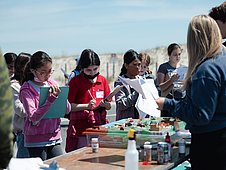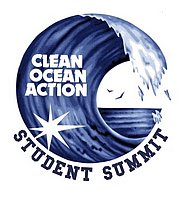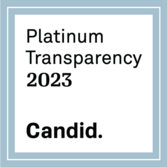Overview of Activities
Student Summits provide schools (grades 5-8) a free opportunity to participate in an educational field trip designed to meet core curriculum standards and reinforce STEM (science, technology, engineering, and mathematics) concepts, as well as support classroom education programs. Student Summits turn a class trip into a Seaside Symposium providing a unique, educational program combining peer-to-peer learning with outdoor experiences emphasizing personal connections to sea and environmental stewardship. Expanding learning beyond the classroom, Student Summits provide an opportunity to experience hands-on, get your feet wet and hands sandy, marine environmental education at the Jersey shore that they will always remember.
Opening Talk:
Introduction to Limulus (Spring)
- The Symposium will begin with a presentation about one of NJ’s unique and ancient marine animals, the horseshoe crab (Limulus). Students learn about the life history of this species that pre-dates the dinosaurs, the myths about this animal, its role in the ecosystem, the biomedical and economic importance to humans, and how we have impacted the species. Students will be shown the proper way to handle the horseshoe crab so they can get a closer look at this valuable species.
Introduction to Diamondback Terrapins (Fall)
- Terrapins are turtles that inhabit estuaries along the east and Gulf coasts of the United States. Terrapins were harvested in the late 1800's through the early 1900's as a food source with a high demand leading to reductions in their populations across their range. Students learn about the life history of this species, interesting variations in their marking attributed to genetic diversity, its role in the ecosystem, and how we have impacted the species. Researchers in the field will also provide a brief discussion about diamondback terrapin conservation and wildlife practices. Students will be shown the proper way to hold and handle the terrapins so they can get a closer look at this interesting species.

Part 1: Activity Roundtable ~ Environmental Extravaganza
An interactive series of work stations with a variety of hands-on activities for students to learn about the environment. Topics will be focused on the causes and effects of Superstorm Sandy. Some of the topics covered may include nonpoint source pollution & marine debris, climate change & sea level rise, the importance of natural areas, and how to make a difference. The roundtables allow for peer-to-peer learning with the participating students engaging with high school students who are responsible for teaching the lessons.
Part 2: Field Activities
Students will be divided and will participate in one of the field activities. The goal is that each school will have students who have attended all field workshops.Trips will be focused on the causes and effects of Superstorm Sandy.
Examples of field activities include*:
- Seining and Marine Animal Identification
- NJ’s estuaries offer a variety of habitats as important breeding, feeding, and nursery grounds for a diversity of fish and invertebrate species. Students will use seine nets and sieves to collect fish and invertebrates to observe and identify common marine animals found in the local bays.
- Birds of the New Jersey Shore
- New Jersey is within the Atlantic Flyway, providing a diverse viewing of coastal birds throughout the year. Students will join local birding experts in a survey and identification of coastal birds. Students will learn how wildlife habitats were affected by Superstorm Sandy.
- Barrier Beach Profiling
- Waves, wind, and currents shape New Jersey's barrier beaches. As a result of these forces, beaches are dynamic, ever-changing environments. By making a beach profile, students will understand sand distribution, beach zones, and tidal water levels. Graphing their results allows students to understand beach topography, the importance of the natural environment, and the impacts of Sandy on the NJ coastline.
- Understanding Marine Debris
- Marine debris includes trash and other objects that get into the marine environment as a result of careless handling and disposal. The problem of marine debris has emerged as a critical environmental issue worldwide. Debris in the marine environment can harm marine life and litter the shore. Students will learn about the types, quantities, and sources of marine debris plaguing our coastal region and will participate in a cleanup.
*Activities are subject to change without notice.


